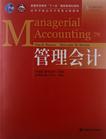管理会计
出版时间:2005-2 出版社:高等教育 作者:于增彪 页数:624 字数:1000000
前言
自教育部在《关于加强高等学校本科教学工作提高教学质量的若干意见》【教高(2001)4号】中提出双语教学的要求后,各地高校相继开设了一系列双语教学课程。这对提高学生的学科和外文水平,开阔国际视野,培养创新型人才起到了重要的作用;一大批教师也逐渐熟悉了外文授课,自身的教学水平和能力得到较大提高,具备国际学术思维的中青年教师脱颖而出。同时,经过近几年的双语教学实践,国外原版教材量大、逻辑不够清晰、疏离中国现实等问题也影响了双语教学的效果。因此,对外版教材进行本土化的精简改编,使之更加适合我国的双语教学已提上教材建设日程。 为了满足高等学校经济管理类双语课程本土化教学的需要,在教育部高等教育司的指导和支持下,高等教育出版社同Thomson Learning等国外著名出版公司通力合作,在国内首次推出了金融、会计、经济学等专业的英文原版改编教材。本套教材的遴选、改编和出版严格遵循了以下几个原则: 1.择优选取权威的新版本。在各专业选书论证会上,我们要求入选改编的教材不仅是在国际上多次再版的经典之作的最新版本,而且是近年来已在国内被试用的优秀教材。 2.改编后的教材力求内容规范简明,逻辑更加清晰,语言原汁原味,适合中国的双语教学。选择的改编人既熟悉原版教材内容又具有本书或本门课程双语教学的经验;在改编过程中,高等教育出版社组织了知名专家学者召开了数次改编和审稿会议,改编稿征求了众多教师的意见。 3.改编后的教材配有较丰富的辅助教学支持资源,教师可在网上免费获取。同时,改编后的教材厚度适中,定价标准较低。 由于原作者所处国家的政治、经济和文化背景等与我国不同,对书中所持观点,敬请广大读者在阅读过程中注意加以分析和鉴别。 此次英文改编教材的出版,得到了很多专家学者的支持和帮助,在此深表谢意!我们期待这批英文改编教材的出版能对我国经济管理类专业的教学能有所帮助,欢迎广大读者给我们提出宝贵的意见和建议。
内容概要
本书将传统管理会计内容与现代管理会计融为一体,突出20世纪80年代以来为适应高新技术、信息时代、全球化竞争和企业权力集中的需要而发展起来的新理论、概念和方法,包括作业成本计算、作业预算、激励制度、质量成本、环境成本、平衡计分卡等。全书共分19章,系统介绍了管理会计的基本知识:成本归集与产品成本(第2章至第7章);计划与控制(第8章至第14章);管理决策(第15章至第19章)等。 作为一本在海外深受欢迎的著名管理会计教材,本书案例丰富,理论与实践紧密结合,非常适合会计专业和非会计专业的高年级本科生和研究生,以及MBA学生选作管理会计教材。
作者简介
Don R.Hansen,美国俄克拉荷马州立大学会计学教授,他的研究兴趣包括作业成本管理和计
量模型,是美国《会计评论》编辑。
书籍目录
1 Introduction: The Role, History, and Direction of Management Accounting Management Accounting Information System Management Accounting and Financial Accounting A Brief Historical Perspective of Management Accounting Current Focus of Management Accounting The Role of the Management Accountant Management Accounting and Ethical Conduct Certification Summary of Learning Objectives Key Terms Questions for Writing and Discussion Exercises ProblemsPART 1: Cost Accumulation and Product Costing 2 Basic Management Accounting Concepts Cost Assignment: Direct Tracing, Driver Tracing, and Allocation 30 Product and Service Costs External Financial Statements Types of Management Accounting Systems: A Brief Overview Summary of Learning Objectives Key Terms Questions for Writing and Discussion Exercises Problems Managerial Decision Cases Research Assignments 3 Activity Cost Behavior The Basics of Cost Behavior Activities, Resource Usage, and Cost Behavior Methods for Separating Mixed Costs into Fixed and Variable Components Reliability of Cost Formulas …… 4 Activity-Based Costing 5 Job-Order Costing 6 Process Costing 7 Support Department Cost AllocationPART 2 Planning and Control 8 Functional and Activity-Based Budgeting 9 Standard Costing:A Managerial Control Tool 10 Activity-and Strategic-Based Responsibility Accounting 11 Quality Costs and Productivity:Measurement,Reporting,and Control 12 Environmental Cost Management 13 Performance Evaluation in the Decentralized Firm 14 International lssues in Management AcfountingPART 3 Managerial Decision Making
章节摘录
版权页: 插图: Managerial Judgment Managerial judgment is critically important in determining cost behavior, and it is byfar the most widely used method in practice/Many managers simply use their experience and past observation of cost relationships to determine fixed and variable costs. This method, however, may take a number of forms. Some managers simplyassign particular activity costs to the fixed category and others to the variablecategory, ignoring the possibility of mixed costs. Thus, a chemical firm may regard materials and utilities as strictly variable with respect to pounds of chemical produced and all other costs as fixed. Even labor, a traditional and common example of a unit-based variable cost, may be fixed for this firm. The appeal of thismethod is simplicity. Before opting for this course, management would do well tomake sure that each cost is predominantly fixed or variable and that the decisions being made are not highly sensitive to errors in classifying costs. To illustrate the useof judgment in assessing cost behavior, consider Elgin Sweeper Company, a leading manufacturer of motorized street sweepers. Using production volume as the costdriver, Elgin revised its chart of accounts to organize costs into fixed and variable components. Elgin's accountants used their knowledge of the company to assign expenses, using a decision rule that categorized an expense as fixed if it were fixed75 percent of the time and variable if it were variable 75 percent of the time. Management may instead identify mixed costs and divide these costs intofixed and variable components by deciding just what the fixed and variable partsare--that is, using experience to say that a certain amount of a cost is fixed andthat, therefore, the rest must be variable. For example, a factory may put the leasepayments for a photocopier into one account and the cost of paper and toner intoanother. The result is that it is easy to group the lease account with other fixed costaccounts and to treat the variable costs separately. Then, the variable component canbe computed using one or more cost/volume data points. This has the advantage ofaccounting for mixed costs but is subject to a similar type of error as the strictfixed/variable dichotomy. That is, management may be wrong in its assessment. Finally, management may use experience and judgment to refine statisticalestimation results. Perhaps the experienced manager might "eyeball" the data andthrow out several points as being highly unusual or might revise results of estimation totake into account projected changes in cost structure or technology. Martin Color-Fi, arecycler, found itself paying top prices for discarded plastics. Demand for recycl able plastics had mushroomed, and prices tripled in the space of a year. The reason for thegrowth in demand? A run-up in the price of cotton due to poor crops in China,Pakistan, and India. The shortage of cotton led Asian mills to substitute polyester andother synthetics. These synthetic fabrics are made from PET (the polyethyleneterephthalate found in recyclable plastic bottles). Companies like Martin must lookforward, not backward, to predict the impact of demand for substitute products onprices and profits.7 Statistical techniques are highly accurate in depicting the past, butthey cannot foresee the future, which is, of course, what management really wants. The advantage of using managerial judgment to separate fixed and variable costs is its simplicity. In situations in which the manager has a deep understanding of the firm and its cost patterns, this method can give good results. However, if themanager does not have good judgment, errors will occur. Therefore, it is important to consider the experience of the manager, the potential for error, and the effectthat the error could have on related decisions.
编辑推荐
《普通高等教育"十一五"国家级规划教材•高等学校会计学类英文版教材:管理会计》作为一本在海外深受欢迎的著名管理会计教材,案例丰富,理论与实践紧密结合,非常适合会计专业和非会计专业的高年级本科生和研究生,以及MBA学生选作管理会计教材。
图书封面
评论、评分、阅读与下载
用户评论 (总计1条)
- 书质量还不错吧,祝兴通
